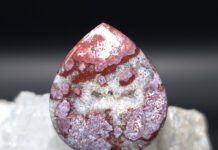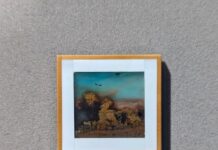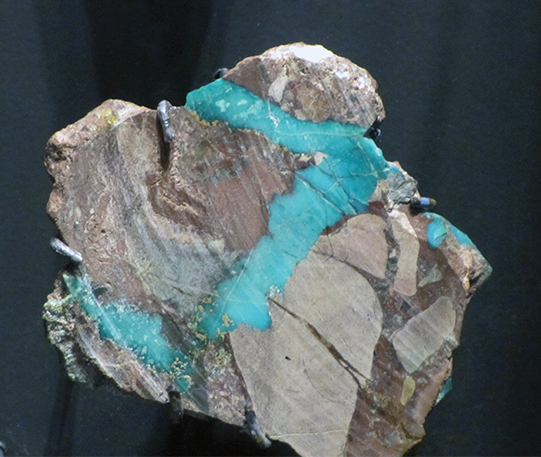
Turquoise played a major part in one of the gifts that ruler Moctezuma II lavished upon Spanish conquistador Hernán Cortés when he arrived in the Aztec Empire in 1519. The chest ornament depicting a double-headed serpent is displayed today in the British Museum in London. This 20-inch-long, 8-inch-high ornament, inlaid with white shell, red coral, and thousands of blue turquoise pieces is among the most extraordinary pre-Columbian artifacts to survive the Spanish conquest of what is now Mexico.
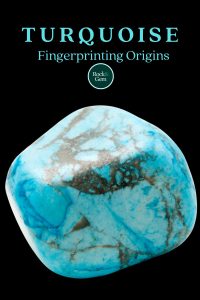
Turquoise held a special place in the Aztec value system. Its rarity alone made it precious; even more importantly, its blue-green color signified the land’s fertility, one of the Aztec culture’s major precepts. Also symbolizing water, new growth, and the revered quetzal bird’s feathers, it was sacred to the Aztecs and the contemporary Mixtec culture and the Mayans who preceded them.
Identifying a Source
The colorful mineral is prominent among the artifact materials of the Aztec, Mixtec, Zapotec, Tarascan, and Mayan pre-Columbian cultures of Mesoamerica (a region stretching from southern Mexico to Honduras), and archaeologists have long debated its source. However, most have agreed that Mesoamerican turquoise was actually mined 1,200 miles to the north in what is now the American Southwest, and then brought to Mesoamerica via an extensive trade system that operated for centuries.
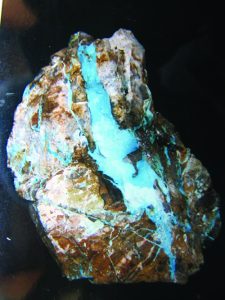
The evidence supporting this theory, while circumstantial, is nevertheless convincing. First, Mesoamerica has no documented turquoise deposits, while the Southwest has many. Second, the peak Mesoamerican use of turquoise coincides closely with the height of pre-Columbian turquoise mining in the Southwest. Finally, the recovery of copper bells, cacao, scarlet macaw feathers, and other Mesoamerican trading commodities from southwestern cultural sites indicates the existence of some level of commerce between Mesoamerica and the Southwest.
Establishing Provenance
Nevertheless, without scientific proof, the existence of this turquoise-trading system was just a theory that could be proved—or disproved—only when chemical testing positively linked turquoise specimens to their deposits of origin. Initially, establishing the provenance of turquoise or, as geochemists now say, “fingerprinting,” turquoise, seemed a simple matter of basic chemistry that called for identifying a chemical characteristic of turquoise unique to each mine source. But as it turned out, fingerprinting turquoise would be a complex process developed only after a century of trial-and-error experimentation.
But the early effort has now paid off. By measuring the isotopic ratios of trace elements in turquoise specimens and comparing them with the proportions in databases representing the host rock of turquoise deposits, researchers are now beginning to trace turquoise specimens to their source reliably.
Emergence of Turquoise-Related Subscience
Although this subscience is still in its developmental stages, initial results have already raised eyebrows among archaeologists and anthropologists by refuting two long-prevailing theories: First, that Mesoamerican specimens came from the American Southwest and, second, that New Mexico’s Chaco Canyon culture, the greatest of all pre-Columbian turquoise-working societies, obtained all its turquoise from the nearby Cerrillos mines. As a result, scholars are now rethinking the entire picture of the pre-Columbian turquoise trade.
About Turquoise
Turquoise is a basic copper aluminum phosphate with the chemical formula CuAl6(PO4)4(OH)8·4H2O. Ideally, its weight consists of 7.81 percent copper, 19.90 percent aluminum, 15.23 percent phosphorus, 55.08 percent oxygen, and 1.98 percent hydrogen. Turquoise is one of the 300-plus members of the phosphates, arsenates, and vanadates class of minerals.
Crystallization occurs in the triclinic system, which has three axes of different lengths, none perpendicular to the others. Because this low-symmetry arrangement inhibits crystal development, turquoise macro crystals are rare, small, and poorly formed. Most turquoise consists of tightly bonded microcrystals in massive or compact forms. The close atomic packing creates strong atomic bonding and a substantial hardness of Mohs 5.0-6.0.

Turquoise is one of five members of the turquoise group of closely related triclinic phosphates, which includes chalcosiderite [basic copper iron phosphate, CuFe6(PO4)4(OH)8·4H2O]. Turquoise and chalcosiderite form a solid solution series in which ferric iron (Fe3+) replaces aluminum (Al3+) and vice versa. When close to its ideal composition, turquoise is a “robin’s-egg blue” color; increasing amounts of iron impart a pronounced greenish shift.
As a secondary mineral, turquoise occurs in shallow oxidation zones of copper-rich deposits. The copper in turquoise is derived from the alteration of copper-sulfide minerals, aluminum from the alteration of feldspar and clay minerals, and phosphate radicals from groundwater-dissolved fluorapatite [calcium fluorophosphate, Ca5(PO4)3F]. Turquoise forms in low temperatures and pressures, as well mainly in warm, arid climates. Hydrothermal deposition typically creates thin veins, fracture coatings, and nodules.
Ancient Appreciation and Application
The reverence for and appreciation of turquoise in the Americas originated in Mesoamerica. Archaeologists have contextually dated the earliest known Mesoamerican turquoise artifacts to 650 B.C. at the beginning of the Mayan Preclassic Period. The use of turquoise in Mesoamerica remained limited until about 1000 C.E. in the Mayan Postclassic Period, after which it began to appear more frequently in masks, jewelry and mosaic inlays.
Turquoise had its most significant importance among the Aztecs. After 1430 C.E., during the Aztec Late Postclassical Period, turquoise was used in the shields and hilts of sacrificial obsidian knives and personal ornamentation and masks. The most prominent use was in elaborate mosaics that were inlaid with thousands of small turquoise tiles.
In the American Southwest, turquoise mining did not begin until around 200 B.C.—450 years after the Mayans first mined it in Mesoamerica. Anthropologists conclude that turquoise’s ritualistic and economic uses evolved in Mesoamerica and spread northward to reach the Southwest eventually. Southwestern turquoise production increased rapidly after 850 C.E., when Ancestral Puebloans began large-scale, systematic mining at Cerrillos, just south of present-day Santa Fe, New Mexico. Simultaneously, 100 miles northwest of Cerrillos, the Chaco Canyon culture was entering a period of rapid expansion and development. By 950 C.E., Chaco Canyon had become the Southwest’s leading source of worked turquoise and the hub of a high-volume turquoise trade.
Chaco Canyon was abandoned around 1150 CE, almost at the same time that large-scale turquoise mining ended at Cerrillos. Chaco Canyon’s abandonment has been variously attributed to the closure of the Cerrillos mines, economic failure due to competition with other southwestern turquoise sources, or the effects of a prolonged drought—or perhaps a combination of all these factors.
Turquoise in Silver
Records and artifacts revealed the modern history of southwestern turquoise dates to the 1880s when Anglo-Americans began commercial mining. During this same period, members of such Native American groups as the Navajo, Hopi, and Pueblos began setting turquoise in silver (the latter obtained by melting down U.S. silver dollars) and selling this jewelry to travelers on the newly built railroads.
By 1910, the image and future of turquoise marketing in the United States had been firmly established: As the Southwest’s iconic gemstone, turquoise would subsequently be set in silver mounts of “Indian” and “southwestern” designs, and color enhancement of using blue aniline dyes, would become common.
As its popularity soared, provenance became an issue. Turquoise from such classic sources as Cerrillos had considerably greater consumer appeal and brought higher prices than generic stones or stones from lesser-known sources. But because origin could not be proven, it was often misstated for marketing purposes. The hope was that scientists soon would develop a method to determine turquoise provenance positively. Archaeologists were also interested in determining the origins of turquoise mainly to prove their new ideas regarding pre-Columbian turquoise trading patterns, the growing belief that large quantities of southwestern turquoise had ended up in Mesoamerica.
First Efforts to Confirm Provenance
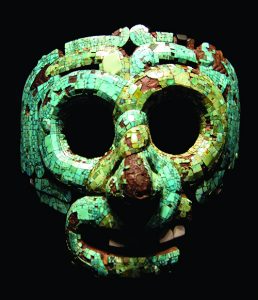
The first efforts to determine turquoise’s provenance were based on visual appearance, specifically color, type of veining, and nature of the matrix, along with general assessments of hardness and workability. The chances of visually determining origin were best with natural matrix specimens. They were much poorer with worked turquoise because cutting and polishing eliminated certain natural characteristics—a particular concern to archaeologists. Because most turquoise artifacts recovered from cultural sites had been worked into beads and tiny inlay pieces, attempts to establish provenance were largely guesswork initially.
Chemists first tried to determine turquoise provenance with simple quantitative tests and qualitative spectrographic analyses. However, problems quickly arose due to turquoise’s inherent chemical complexity. Because turquoise deposits often form through multiple-phase hydrothermal emplacement, wide compositional variations in both primary and trace elements, even among specimens from the same deposit, made single-element analyses ineffective.
A Chemical Signature
Researchers eventually realized that the key would be to identify a specific, measurable chemical signature constant in both turquoise specimens and their original mineralogical environment, yet sufficiently unique to differentiate individual specimens and their deposits of origin. But finding this signature would be akin to seeking the proverbial needle in a haystack.
By the 1990s, researchers had tried X-ray fluorescence, arc-emission spectrometry, neutron-activation, and electron-microprobe methods, along with comprehensive computer analyses of the mathematical values of turquoise’s basic and trace elements. While the results were sometimes encouraging, overlapping data prevented identifying chemical signatures that were unique for individual turquoise deposits.
In 2004, researchers turned their attention to elemental isotopes. Isotopes are atoms of the same element with the same general chemical properties of the parent element but with different numbers of neutrons and a different atomic mass. Geochemists first measured traces of the isotopic lead that are always present in turquoise, only to find that single-isotope data, like single-element data, could not differentiate individual deposits.
Next, they measured the ratios between two elemental isotopes, working first with hydrogen-oxygen ratios, then moving on to copper-hydrogen ratios to achieve their first success. In 2010, using the copper-hydrogen approach, they conducted 800 analyses of turquoise specimens from 22 southwestern deposits. They correctly sourced 42 of 74 turquoise artifacts recovered from cultural sites in Utah and Nevada after building a database. The inability to source all the specimens was mainly because the chemical signatures of all southwestern turquoise deposits had not yet been entered into a database.
Chaco Canyon Specimens
Research with specimens from New Mexico’s Chaco Canyon is particularly interesting. Chaco Canyon, now protected as Chaco Culture National Historical Park and designated a United Nations Educational, Scientific and Cultural Organization World Heritage Site, has yielded a quarter-million pieces of turquoise, the most of any site in the world. This turquoise consists mostly of drilled beads, pendants, and mosaic-inlay pieces.
Within the greater Chaco Canyon cultural region are the ruins of several “great houses,” large, multistory Ancestral Puebloan structures, each of which was a semi-independent community of turquoise workers. Analyses of specimens from these sites showed that only the Pueblo Bonito Great House worked with Cerrillos turquoise. This information was the first major revelation about the Southwest’s pre-Columbian turquoise trade. Turquoise specimens from Chaco Canyon’s other great houses had come from mines in California, Nevada, and Colorado.
Archeologists now believe that Pueblo Bonito had monopolized the Cerrillos mine supply while the other great houses obtained their turquoise through trade with groups far to the west. Apparently, this was often a two-way trade, as Cerrillos turquoise has been found at sites in California, Utah, and Nevada. By the time these revelations were announced, researchers were already developing an even more reliable technique that measured the isotopic ratios of lead and strontium in turquoise. In 2012, researchers used this method to analyze 150 specimens to compile a database of dozens of turquoise deposits in California, Arizona, New Mexico, and Colorado, all of which showed evidence of pre-Columbian mining.
Pre-Columbian Mosaic Tiles
Next, they analyzed two groups of pre-Columbian turquoise mosaic tiles. One had been excavated from the Templo Mayor, the Aztec Empire’s ceremonial and ritual center, in present-day Mexico City. The second group, from the Smithsonian’s National Museum of the American Indian, consisted of artifacts of the Mixtec culture, an advanced civilization in western Mexico that paid tribute to the Aztecs.
Isotopic signatures of the turquoise in both groups were consistent not with the geology of the Southwest but with that of Mesoamerican crustal rocks and native-copper deposits. This signature result was the first clear evidence that Mesoamerican turquoise did not come from the American Southwest. It also raised the obvious question: Where did the Mesoamerican turquoise originate?
Mesoamerican Sources
Although no Mesoamerican turquoise sources have yet been documented, 19th-century ethnohistorical and archaeological literature includes second-hand reports of turquoise deposits in Jalisco’s Mexican states Puebla west and south, respectively, of Mexico City. These regions have numerous, albeit small native-copper deposits mined in pre-Columbian times to obtain metal for tools, bells, and ax heads. Archaeologists have also found evidence of crude, pre-Columbian copper smelters that treated locally mined, oxidized copper ores.
Turquoise could undoubtedly have been present in these native copper and oxidized copper deposits. And because turquoise occurrences are always small and shallow, they also could easily have been mined out, destroyed by native copper or oxidized copper-mineral mining, or lost and overgrown in the long period of societal collapse that followed the Spanish conquest.
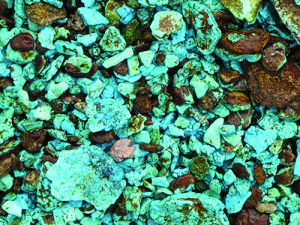
The lead-strontium test results indicate only that Mesoamerican turquoise did not come from the American Southwest. The lead-strontium ratios are consistent with the surface geology of Mesoamerica. In the absence of known turquoise sources, this data does not yet link the Mesoamerican turquoise to any specific regional sources. But archaeologists are already looking closely at the known Mesoamerican native-copper deposits. Should turquoise be found here, lead-strontium tests will reveal if these particular deposits were among the turquoise sources in pre-Columbian artifacts.
Lead-Strontium Fingerprinting
While the lead-strontium turquoise-fingerprinting technique offers excellent promise to gain insight into pre-Columbian turquoise-use patterns, a database must first be compiled of all known southwestern turquoise sources. However, the lead-strontium analytical process itself is neither quick nor simple. As one researcher points out, it is not “something that can be done in the garage.”
Specimens must first be identified as turquoise and not another similarly colored, oxidized copper mineral, such as malachite or chrysocolla, each of which often masquerades as artifact turquoise. The chemical composition must be confirmed with such nondestructive techniques as X-ray diffraction and scanning electron microscopy. Specimens must then be cleaned of all residue or adhesive material, crushed to a powder, cleaned again, dissolved in acid, precipitated, dried, then prepared for specific tests. Only after this test material is degassed on titanium filaments can thermal-ionization mass spectrometers measure strontium-isotope levels and plasma-mass spectrometers measure lead-isotope levels.
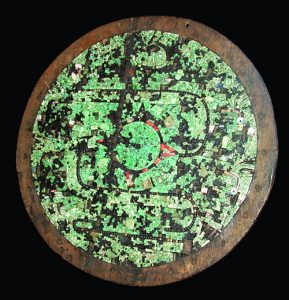
WIKIMEDIA COMMONS
A Destructive Process
Although lead-strontium isotopic analysis requires only tiny specimens, it is nevertheless a destructive process that is not suitable for all museum artifacts. Isotopic analysis may soon be used to determine the provenance of the turquoise in Egyptian artifacts. The turquoise used as early as 3200 B.C. in Early Dynastic Egypt was probably obtained from deposits in the nearby Sinai Desert. But after 1000 B.C. the nature of the turquoise in Egyptian artifacts seems to have changed. Some Egyptologists suggest that the Sinai mines had been depleted and that the new turquoise was coming from Persia (now Iran), 1,500 miles to the northeast—a theory that could be confirmed by lead-strontium isotope analysis.
Although still in its formative stages, the specialized subscience of turquoise fingerprinting has already provided fascinating new insight into pre-Columbian cultural and economic relationships, the scope of ancient trade routes, and the origin of Mesoamerican turquoise. And when advanced, nondestructive, and economical isotope-ratio techniques become available in the not-so-distant future, we may finally know if our prized specimens of Cerrillos turquoise are really from Cerrillos.
This article previously appeared in Rock & Gem magazine. Click here to subscribe. Story by Steve Voynick.



